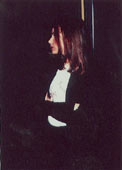|
|
|
| Galleria Marabini |
| |
Paul Graham End of an Age
Paul Graham’s most recent series, End of An Age (1999), consists of forty-nine large-scale photographs of young people in their twenties hanging out in night clubs in the US or Western Europe. The majority of these images are portraits: single, unconscious, un-posed subjects are usually shot in profile against the backdrop of a wall. None of the subjects look directly into the camera. One, like Betty in Gerhard Richter’s homonymous 1988 painting, is turned three quarters to face a red-gold sea. Some photos are taken with a harsh, hyper-defined flashlight, others with more unruffled, natural lighting in denser colors: they are silent images taken in noisy locations, still images taken in places of movement.
Graham reneges the first rule of portraiture—that the subject should look directly into the camera—and, indeed, abandons most of the rules of professional photography. Some images are out of focus; others are almost completely obscured by touches of color. What makes them successful is their combined conceptual strength. Almost all these young people have the same expression on their faces: an open, searching look, as though they are slightly stunned. Although they are faithful portraits, in so much as they aim to “draw” something from each subject, this “something” is collective rather than individual. In contrast to Graham’s previous series about Ireland — Troubled Land (1984-87), landscapes in which small political messages emerge—and about Japan — Empty Heaven (1989-1995), in which Graham portrayed details of car engines, wrapped trees, scarred fabrics, and other symbols of occultism —, End of An Age avoids any specific cultural reference. In essence, these most recent works are portraits of a collective condition rather than a particular societal group or nationality.
Over the course of the last twenty years, Graham has become a talented interpreter of a distinctly allegorical form of photography in which the apparent succession or repetition of surfaces contemporaneously illustrates something deeper. The most profound subject that End of An Age touches upon is the passage from innocence to experience. The young night-clubbers depicted all hang on the threshold between childhood and adulthood, the personal and the social. In this respect, the fact that they are all portrayed as spectators is highly revealing. They stand at the edges of the action like actors waiting behind the curtains to go on stage. They smoke, listen, and watch. Their complete absorption heightens their vulnerability and endows them with a particular beauty in this state of expectation that Graham captures with great skill. Yet this tenderness is undermined by a certain zombie-like coldness. The series can be read as both a portrait of a generation and a portrait of an era: the present.
Graham was born in England in 1956, currently dividing his time between London and New York. Working as an artist-photographer for the last twenty years, Graham has shown in numerous galleries and museums, including London’s Tate Gallery in 1996. His latest series of photographic works, Paintings (2000), was shown at the last Venice Biennale. A number of his works have recently been purchased by the Museum of Modern Art in New York.
|

Untitled, 1996 - 98
1996-98
|
|
|
|
|
